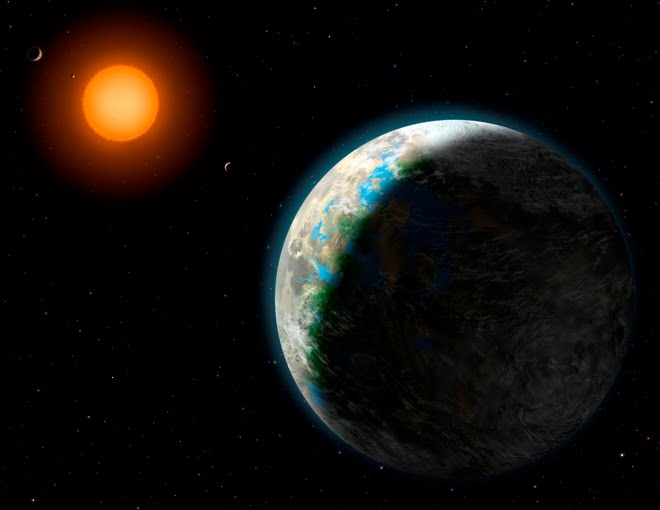Twin Suns and Exoplanets, a rockin' week!
This corner of Our Universe is filled with delight this week by the news of a planet orbiting two suns, and so many newly-discovered exoplanets are surely cream cheese icing on this pineapple-walnut carrot cake. From an excellent report by Rob Simpson on Astronomy Blog:
Over the past week we've had a slew of planet announcements including: 50 candidates discovered with HARPS (on the VLT) on Monday; 23 discovered with WASP on Tuesday; and another 7 announced since yesterday. The discoveries this week have been due to astronomers saving up announcements for the Extreme Solar Systems conference in Wyoming. They've taken the total number of exoplanet candidates up to 684! Will we reach 1000 by the end of the year?
This new system is remarkable because it is the first planet found to orbit a double star system. This is really helpful because it provides many different types of transits (each of the stars transiting each other as well as transits involving the planet) and these allow absolute values for the properties of the system. Normally a transit provides the relative sizes of the star and planet and you then have to use stellar evolution models to estimate the mass of the star and get the absolute sizes.
The paper establishes that the system contains 0.2 and 0.7 solar mass stars that orbit around a common centre of mass every 41 days. They are, in turn, orbited every 229 days by a planet with about 0.33 the mass of Jupiter and about 0.75 the radius of Jupiter.
The stars are separated by about 0.2 AU and the planet's orbit is 0.7 AU so the planet will experience temperature variations depending on which star is closer. Based on models of the star types, it is estimated that the temperature ranges from about 170 - 200 K so this will be a pretty cold world unlike Tatooine. They calculate a mean density close to water but say (based on models of planetary interiors and estimates of the planet's age) it is likely to be about half gas (hydrogen/helium) and half heavier elements (rock/ice?).
They were fairly lucky to spot this system when they did. The inclination of the planet's orbit varies. If their models of the orbit are correct, we will not see a transit of the second star from 2014-2049 and we won't see the planet transit the larger star from 2018-2042. So, if Kepler had suffered a 10 year delay to launch it would never have seen this system during its 3.5 year mission and may have had to wait until the mid 21st century to know about it.
Read the full Rob Simpson Astronomy Blog article on new circumbinary planet and 2011 expolanet discoveries.
Keep the good news rolling!
Astronomy blog with news on Gliese 581g, Exoplanets, 2012 Transit of Venus, Zarmina's World, exoplanetary exploration, Extreme Supermoons, Kepler telescope, 2012 astronomy, Maya prophecies, links to astronomy websites, 2012 Transit of Venus, 21st century architecture, astronomers, solar energy, astronomical news.
Is There LIFE on Planet GJ581g?
GJ 581 g is an Earth-like planet recently discovered orbiting Gliese 581, a red dwarf star categorized as M Dwarf. This new discovery is perceived by scientists as as a Goldilocks type sphere - not too hot, not too cold. Nicknamed Zarminas World (after his wife Zarmina) by project leader Steven S Vogt, GJ581g will fascinate and enthrall Earthlings for generations to come.
GJ581G Orbiting Gliese 581

Earth Has A Twin
Solar Powered System

Astronomy News Info Photos Telescopes
Chitika Network Links
Astronomy For Everyone
Green Mutual Fund Investing Info
Popular Posts
-
BEIJING -- China plans to launch space labs and manned ships and prepare to build space stations over the next five years, according to a pl...
-
To me it seems likely that the Transit of Venus in 2012 is the most obvious reason the Mayan priests would define 2012 as the end of one er...
-
Meteor shower to be obscured by daylight, full moon CAPE CANAVERAL, Fla. -- Heads-up, meteor fans. As many as 750 meteors an hour are expect...
-
Here are some of the most recent Mars images released by NASA, taken from the Curiosity rover in recent days: Check b...
-
Sustainable Tourism: A Key to Global Solutions by Dr. Reese Halter and Dr. Dave Randle When most people think of tourism, they probably don...
astronomycentral.co.uk
Best Green Stocks Investing Blog
NASA Watch
Subscribe to:
Post Comments (Atom)
GJ581g Zarminas World Info and Links
Search Green Stocks Investing Network

Custom Search



No comments:
Post a Comment